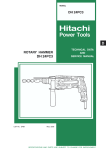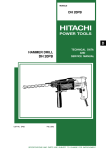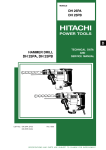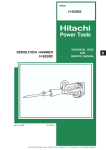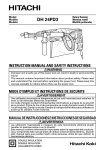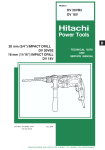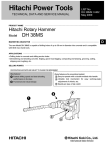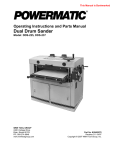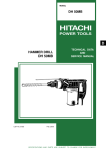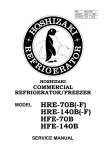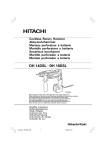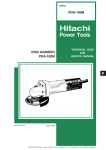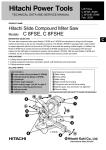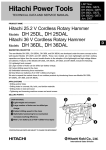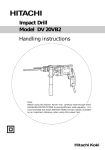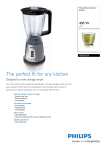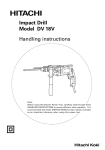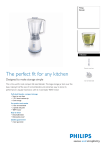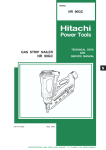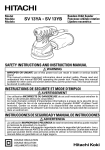Download DH 22PG - hitachi
Transcript
LIST No. E497 Aug. 2007 PRODUCT NAME Hitachi Rotary Hammer Model DH 22PG MARKETING OBJECTIVE The new Model DH 22PG features the concrete drilling capability with the maximum drill bit diameter 22 mm and the use of SDS-plus shank tools. This is a professional-use and low-priced rotary hammer. The main features of the Model DH 22PG are as follows: (1) Most compact and lightweight in its class: 289 mm in overall length and 1.9 kg in weight (2) The internal pressure adjustment mechanism prevents grease leakage. (3) The idle striking prevention mechanism prevents reciprocating motion during no-load operation to reduce noise. APPLICATIONS Drilling holes in concrete, brick and stone Drilling holes in steel and wood Tightening and loosening machine screws and wood screws SELLING POINTS [ NEW FEATURES ] Most compact and lightweight in its class for ease of operation Hitachi’s own internal pressure adjustment mechanism Clutch-cut type idle striking prevention mechanism SPECIFICATIONS AND PARTS ARE SUBJECT TO CHANGE FOR IMPROVEMENT International Sales Division REMARK: For more information about HANDLING INSTRUCTIONS, visit our website at: http://www.hitachi-koki.com/manual_view_export/ Throughout this TECHNICAL DATA AND SERVICE MANUAL, a symbol(s) is(are) used in the place of company name(s) and model name(s) of our competitor(s). The symbol(s) utilized here is(are) as follows: Symbols utilized Competitors Company name Model name B BOSCH GBH2-22RE C MAKITA HR2020 CONTENTS Page SELLING POINT DESCRIPTIONS ---------------------------------------------------------------------------------------- 1 SPECIFICATIONS ------------------------------------------------------------------------------------------------------------- 2 1. Specifications----------------------------------------------------------------------------------------------------- 2 2. Optional accessories ------------------------------------------------------------------------------------------- 3 COMPARISONS WITH SIMILAR PRODUCTS------------------------------------------------------------------------- 7 1. Specifications comparisons ---------------------------------------------------------------------------------------------------------- 7 2. Drilling speed comparison------------------------------------------------------------------------------------- 8 PRECAUTIONS IN SALES PROMOTION------------------------------------------------------------------------------- 9 Safety Instructions-------------------------------------------------------------------------------------------------- 9 REFERENCE MATERIALS-------------------------------------------------------------------------------------------------10 1. Lubrication -------------------------------------------------------------------------------------------------------10 2. Tool structure ----------------------------------------------------------------------------------------------------10 3. Changeover between ”Rotation only” and ”Rotation and hammering” ----------------------------13 4. Precautions for use of ”Rotation only” (no hammering) function------------------------------------13 5. Drill bits -----------------------------------------------------------------------------------------------------------13 6. Tool retainer section -------------------------------------------------------------------------------------------14 7. Dust collector (B) -----------------------------------------------------------------------------------------------15 REPAIR GUIDE----------------------------------------------------------------------------------------------------------------16 1. Precautions in disassembly and reassembly ------------------------------------------------------------16 STANDARD REPAIR TIME (UNIT) SCHEDULES--------------------------------------------------------------------26 Assembly diagram for DH 22PG SELLING POINT DESCRIPTIONS Most compact and lightweight in its class* * Based on our own research The Model DH 22PG is most compact and lightweight in its class thanks to the optimum striking mechanism. HITACHI Maker Model DH 22PG B C Overall length 289 mm 342 mm 352 mm Weight 1.9 kg 2.3 kg 2.3 kg 289 mm Internal pressure adjustment mechanism An air passage is provided as shown below to let out air inside the gear cover and let outside air in the gear cover. This passage is sandwiched between felt packings to pass only air. Thus variations in the internal pressure are minimized for stable hammering operation and prevention of grease leakage. A-A (Inside the Gear cover) Air passage (Outside the gear cover) Felt packing (B) Valve Felt packing (A) Inner cover Idle striking prevention mechanism When the drill bit is lifted from the concrete surface, the reciprocating bearing that converts rotation into reciprocating motion stops to prevent idle striking. Thanks to this mechanism, vibration and noise during no-load operation are reduced. -1- SPECIFICATIONS 1. Specifications mm 22 Inch 7/8 mm Inch 13/24 1/2” / 1” Capacity: Concrete Capacity: Steel/Wood Input power Impact energy No-load rpm (Forward) No-load rpm (Reverse) Full-Load bpm Mode W J min-1 min-1 min-1 – 620 1.4 0-1,500 0-980 0-6,200 2 Variable speed – YES Reverse switch type – Push button Soft grip Handle No Gear cover No mm 289 Inch 11-3/8” m/s2 1.42 m/s2 8.75 dB 83.7 dB 89.2 kg lbs 1.9 4.2 Overall length No load vibration level (Tri-axial, measured) Full load vibration level (Tri-axial, measured) No load noise level (measured) Full load noise level (measured) Weight -2- 2. Optional accessories (1) Drilling anchor holes (rotation and hammering) Drill bit (SDS-plus shank) + Effective length Overall length Outer dia. (mm) Overall length (mm) Effective length (mm) 4.0 4.3 4.5 110 50 4.8 5.0 5.0 5.5 6.0 160 100 110 50 6.0 6.4 6.5 7.0 7.5 8.0 160 100 8.5 9.0 9.5 10.0 10.0 260 200 10.5 160 100 10.5 260 200 11.0 160 100 12.0 166 100 12.0 260 200 Code No. 303571 303572 303573 303574 303575 303578 303576 303577 303579 303580 303581 303582 303583 303584 303585 303586 303587 303588 303604 303589 303605 303590 303591 303606 -3- Outer dia. (mm) Overall length (mm) Effective length (mm) 12.5 166 100 12.5 260 200 12.7 166 100 12.7 260 200 166 100 14.3 260 200 14.5 166 100 14.5 260 200 166 100 260 200 166 100 17.0 260 200 17.5 166 100 17.5 260 200 18.0 166 100 19.0 260 200 250 200 13.0 14.0 14.3 15.0 16.0 16.0 16.5 17.0 20.0 22.0 Code No. 303592 303607 303593 303608 303594 303595 303596 303609 303597 303610 303598 303599 303611 303600 303601 308485 303602 303612 303603 303613 303614 303615 Slender bit and adapter for slender shaft (SDS-plus shank) + (1) Drill bit (slender shaft) + (2) Adapter for slender shaft (SDS-plus shank) (1) Drill bit (slender shaft) Outer dia. (mm) 3.4 3.5 (2) Adapter for slender shaft Overall length (mm) Effective length (mm) Code No. Code No. 90 45 306369 306368 306370 Drill bit (taper shank) + (1) Drill bit (taper shank) + (2) Taper shaft adapter (SDS-plus shank) (3) Cotter (1) Drill bit (taper shank) Outer dia. (mm) 1100 12.3 12.7 14.3 14.5 17.5 (2) Taper shank adapter Code No. 944460 944461 993038 944462 944500 944463 Type Code No. Code No. Morse taper No. 1 303617 944477 13 mm hammer drill chuck + + Rubber cap Straight-shank bit for impact drills (3) Cotter 13 mm hammer drill chuck (SDS-plus shank) Chuck wrench -4- Part name 13 mm hammer drill chuck (including chuck wrench and rubber cap) Chuck wrench Rubber cap Code No. 303332 303334 303335 (2) Anchor setting Anchor setting bar Anchor setting adapter (SDS-plus shank) + Overall length (mm) W-1/4 Anchor setting adapter-A 260 W-5/16 Anchor setting adapter-A 260 W-3/8 Anchor setting adapter-A 160 W-3/8 Anchor setting adapter-A 260 Part name Code No. 302976 302975 303621 302974 Overall Code No. length (mm) W-1/4 Anchor setting adapter-B 260 302979 W-5/16 Anchor setting adapter-B 260 302978 W-3/8 Anchor setting adapter-B 160 303622 W-3/8 Anchor setting adapter-B 260 302977 Part name Internal cone type External cone type (3) Crushing operation (rotation and hammering) + Bull point (SDS-plus shank) Code No. 303046 (4) Drilling holes and driving screws (rotation only) + + Special screw 13 mm drill chuck (13VLRB-D) Chuck wrench Chuck adapter (G) (SDS-plus shank) NOTE: If the tool is to be used for tightening or loosening screws, open the three jaws of the drill chuck and securely fix the drill chuck to chuck adapter (G) with the special screw (a left-hand threaded M6 screw) when mounting the drill chuck onto chuck adapter (G). -5- Part name Code No. Chuck adapter (G) 13 mm drill chuck (with chuck wrench) Special screw (M6 left-hand threaded) 303623 321814 981122 (1) Cross-recessed head (Phillips) bit [Overall length: 65 mm] (For use with cross-recessed head (Phillips) screw) (2) Slotted-head (minus) bit [Overall length: 70 mm] (For use with slotted-head (minus) screw) Tip thickness Stamped bit No. Bit No. Code No. Applicable screw dia. (mm) Bit tip thickness Code No. No. 2 No. 3 983006 983011 3-5 6- 8* 0.8 1 955659 955674 * Temporary tightening (5) Grease for hammer and hammer drill Containing 500 g Code No. 980927 Containing 30 g Containing 70 g Code No. 981840 Code No. 308471 (6) Dust cup and dust collector (B) Dust cup Dust collector (B) Code No. 971787 Code No. 306885 -6- Applicable screw dia. (mm) 4 5- 6 COMPARISONS WITH SIMILAR PRODUCTS (Superior specifications: 1. Specifications comparisons Maker Model name HITACHI DH22PG B C mm 22 22 20 Inch 7/8” 7/8” 13/16” mm 13/24 13/30 13/32 Inch 1/2” / 1” 1/2” / 1-3/16” 1/2” / 1-1/4” Input power W 620 620 710 Impact energy J 1.4 2.2 2.2 No-load rpm (Forward) min-1 0-1,500 0-1,000 0-1,050 No-load rpm (Reverse) min-1 0-980 0-1,000 0-525 Full-load bpm min-1 0-6,200 0-4,400 0-4,050 Mode - 2 2 2 Variable speed - Yes Yes Yes Reverse switch type - Push button CB holder Switch Lever Handle No Yes No Gear cover No No No mm 289 342 352 Inch 11-3/8” 11-15/32” 13-55/64” m/s2 1.42 12.4 8.7 m/s2 8.75 16.8 16.2 dB 83.7 91.3 87.7 dB 89.2 87.1 85.0 kg 1.9 2.3 2.3 lbs 4.2 5.1 5.1 - Yes No No - Yes No No Capacity: Concrete Capacity: Steel/Wood Soft grip Overall length No-load vibration level (Tri-axial, measured) Full-l load vibration level (Tri-axial, measured) No-l load noise level (measured) Full-l Load noise level (measured) Weight Internal pressure adjustment mechanism No-load hammering prevention mechanism -7- ) 2. Drilling speed comparison Drilling speed varies considerably depending on the work conditions. Use the factory test results shown in Fig. 1 for comparison purpose only. Fig. 1 800 HITACHI DH22PG B C 700 600 Drilling speed (mm/min) 500 400 300 200 100 0 2 4 6 8 10 12 14 16 18 20 22 Drill bit dia.(mm) [Test conditions] Direction: Downward drilling Pushing force: 98 N (10 kgf) Test material: Concrete panel with a compression strength of 2,352 N/cm2 (240 kgf/cm2) -8- PRECAUTIONS IN SALES PROMOTION Safety Instructions In the interest of promoting the safest and most efficient use of the Model DH 22PG Rotary hammer by all of our customers, it is very important that at the time of sale, the salesperson carefully ensures that the buyer seriously recognizes the importance of the contents of the Handling Instructions, and fully understands the meaning of the precautions listed on the Caution Plate and Name Plate attached to each tool. A. Handling Instructions Although every effort is made in each step of design, manufacture and inspection to provide protection against safety hazards, the dangers inherent in the use of any electric tool cannot be completely eliminated. Accordingly, general precautions and suggestions for the use of electric power tools, and specific precautions and suggestions for the use of the Rotary Hammer are listed in the Handling Instructions to enhance the safe, efficient use of the tool by the customer. Salespersons must be thoroughly familiar with the contents of the Handling Instructions to be able to offer appropriate guidance to the customer during sales promotion. B. Caution Plate The Model DH22PG unit is provided with a Caution Plate (illustrated below) which lists basic safety precautions in use. Carefully ensure that the customer fully understands and follows these precautions before using tool. [For Australia and New Zealand] [ For the U.S.A. and Canada ] [ For China ] [ For Mexico ] [ For Taiwan ] -9- REFERENCE MATERIALS 1. Lubrication Replenish the grease lubricant when the tool is disassembled or there is grease leakage due to a defective seal. Changing grease is required once a year to extend the service life of the tool. Special grease is used in the striking section. Should the striking section (within the gear cover) be disassembled, remove the old grease from all parts completely and, on reassembly, replenish 30 g of new grease in the gear cover and 10 g in the groove of the inner cover. Be careful not to exceed the designated amount of grease. Excessive grease will reduce striking efficiency. 2. Tool structure Transmission of rotation See Fig. 2. The rotation of the armature is transmitted to the second shaft via the first gear, and causes it to rotate. The second shaft pinion mounted on the second shaft engages with the second gear mounted on the outer circumference of the cylinder. The cylinder is coupled to the second gear by means of a slip mechanism, and they rotate together. The end of the cylinder also functions as the drill bit retainer. The cylinder is key-connected to the inserted drill bit by means of two key rails and a steel ball, and transmits rotation to the drill bit. Piston reciprocating mechanism In the Model DH 22PG, through adoption of a spiral drive system (a mechanism using a reciprocating bearing), a more compact design has been achieved by arranging the motor shaft in parallel with the tool shaft. Figure 2 shows that the drill bit is pressed against the workpiece and the tool shaft is retracted. The rotation of the armature is transmitted to the second shaft via the first gear. The second shaft rotation is further transmitted through a spline to the clutch. The cylinder flange is pressed against the clutch by the retracted tool shaft and the clutch engages with the reciprocating bearing to transmit rotation to the reciprocating bearing. However, ring grooves on the inner race of the reciprocating bearing are positioned on an angle of inclination with relation to the second shaft. Fig. 2 Rod Piston pin Air chamber Piston O-ring Slip mechanism Strike Tool shaft Armature Motor shaft Cylinder Second hammer Second gear Second pinion Clutch First gear Ring groove Ringed ditch Second shaft Cylinder flange Second shaft spline Reciprocating bearing The rotation of the inner race and the shaft causes that angle of inclination to change regularly forward and backward with relation to the second shaft, and produces a rocking motion to the outer race of the reciprocating bearing. Finally, a rod extending from the outer race of the reciprocating bearing is connected to the piston by the piston pin, and causes the reciprocating bearing motion of the piston. -10- Hammering function The piston reciprocates within the cylinder to move the striker in the same manner as in conventional hammer drills. As the piston reciprocates, the changing air pressure inside the air chamber between the piston and the striker causes the striker to move and continuously strike against the end of the second hammer. At the same time, the changing air pressure within the air chamber which moves the striker also provides an “air cushion” which absorbs the impact of the hammering action. As any air leakage from the air chamber would weaken the air-cushion effect and reduce impact absorption, the O-ring (mounted on the striker) is extremely important to seal the air. Although special rubber material is utilized in construction of the O-ring to make its effective service life as long as possible, wear cannot be fully avoided. Accordingly, it is recommended that the O-ring be replaced approximately once a year, depending on the frequency of usage of the tool. Idle striking prevention mechanism The idle striking prevention mechanism in the Model DH 22PG is different from those of conventional hammer drills in other classes. When the drill bit is lifted from the concrete surface on completion of drilling or during no-load operation, the reciprocating bearing that converts rotation into reciprocating motion stops to prevent idle striking. Upon lifting the drill bit from the concrete surface, the tool shaft (cylinder) is moved forward about 5 mm by the force of spring (B) as shown in Fig. 3. Then the clutch is moved forward by the thrust plate that is connected to the cylinder to disengage the clutch from the reciprocating bearing. Thanks to the needle bearing on the second shaft, the reciprocating bearing can idle. Accordingly, rotation of the second shaft is not transmitted to the reciprocating bearing and the reciprocating bearing stops to stop the striking motion of the piston and the striker. The pressing force of spring (B) is as low as 1.0 kg to 2.0 kg in comparison with the conventional mouth system. The Model DH 22PG is also suitable for drilling in upward direction. Fig. 3 5 mm Piston Spring (B) Thrust plate Slip mechanism Striker Tool shaft Cylinder Coil spring Second gear Clutch Reciprocating bearing Needle bearing -11- Cylinder flange Internal pressure adjustment mechanism An air passage is provided as shown in Fig. 4 to let out air inside the gear cover and let outside air in the gear cover. This passage is sandwiched between felt packings to pass only air (pressure). Thus variations in the internal pressure are minimized for stable hammering operation and prevention of grease leakage. Fig. 4 A-A (Inside the Gear cover) Air passage (Outside the Gear cover) Felt packing (B) Valve Felt packing (A) Inner cover Slip mechanism The slip mechanism in the Model DH 22PG consists of a coil spring which applies a pre-set amount of pressure to ensure the interlocking of three claws provided on the flange of the cylinder (the final rotating shaft) and three matching claws provided on the face of the second gear, by which rotation is transmitted to the cylinder. The second gear is fitted on the cylinder with a certain amount of play. If an excessively large torque is applied to the tool shaft (cylinder), the force of the torque will exceed the pressure of the coil spring and cause the claws on the second gear to disengage from and ride over the claws on the cylinder so that the second gear idles and does not transmit rotation. Even should the drill bit come in contact with a reinforcing bar within the concrete, causing sudden excessive torque, the slip mechanism functions to prevent damage to the gears, and possible loss of control of the tool by the operator (slip torque setting applied to the tool shaft: 1.7 to 2.2 kgm). Sealed and dustproof construction The gear cover is totally enclosed by oil seals, O-rings and other devices to prevent leakage of lubricating grease, and to keep dust and dirt out of the internal mechanisms. The drill bit chuck portion is protected by a rubber front cap to keep out dust and chips which could cause improper fitting of the drill bit and/or other faulty operation of the chuck portion. The speed control switch is also fully dustproof to prevent dust and chips from entering the handle section and causing possible operational trouble or a breakdown of the insulation. Speed control The Model DH 22PG is equipped with a variable speed control switch which permits free change of the rotation speed and hammering force. When drilling in fragile materials, pull the switch trigger gently for low rotation speed (hammering force) to achieve optimum results. Note that the switch trigger cannot be pulled to the full but up to the half in the reverse drilling, and the speed is about half of the forward drilling. In addition, the switch stopper cannot be used in the reverse drilling. -12- 3. Changeover between “Rotation only” and “Rotation and hammering” The change lever on the Model DH 22PG permits easy changeover between the “rotation only” and “rotation and hammering” functions. Set the change lever to “rotation and hammering” ( marks). Press the drill bit against the workpiece and pull the switch trigger. Then the armature starts rotating, and the rotation and the striking force are transmitted to the drill bit by the mechanism as described in page 10 “Piston reciprocating mechanism.” After drilling, take the drill bit away from the workpiece. Then the rotation of the reciprocating bearing and the hammering operation are stopped by the idle striking prevention mechanism as described in page 11. Set the change lever to “rotation only” ( mark). The stopper of the change lever contacts the rear surface of the thrust plate that is pushed forward by spring (B). Thus the cylinder cannot go back even if the main body is pressed, and the claws on the clutch cannot engage the matching claws on the reciprocating bearing. The reciprocating bearing idles on the second shaft and only the rotation is transmitted to the drill bit. 4. Precautions for use of “Rotation only” (no hammering) function The Model DH 22PG is equipped with a change lever for changeover between “rotation only” and “rotation and hammering” functions. Be sure to set the change lever to “rotation only” for drilling into wood or metal materials or for driving screws by means of the optional chuck adapter or drill chuck. Should the change lever be set to “rotation and hammering” when such an optional tool is used for drilling or driving screws, the hammering action may cause the drill chuck or other optional tool to be broken or damaged. Salespersons should carefully ensure that the buyer is thoroughly advised on this point. 5. Drill bits The chuck section is designed exclusively for the popular and widely available SDS-plus shank bits, as shown in Fig. 5. Rotating torque is transmitted to the drill bit by two key rails provided in the tool holding section. A steel ball is used to prevent the bit from falling out. Fig. 5 The service life of a drill bit with a diameter of 8 mm is approximately 300 holes when drilling into concrete with a depth of 30 mm. If reground before the end of its service life, the drill bit will continue to provide efficient drilling. Figure 6 shows the regrinding angle. -13- Fig. 6 6. Tool retainer section The tool retainer is structured as shown in Fig. 7. The tip of the tool retainer is covered with the front cap (made of rubber) to prevent dust and chips from getting inside. The steel ball falls into the round groove of the bit to prevent the tool from coming off and the two key rails transmit the rotation torque. To mount the bit, push the bit in the tool retainer as far as it will go. Pushing lightly, turn the bit until it is caught. At this position, push the bit in as far as it will go (sliding the grip is not required for mounting the bit). To remove the bit, slide the grip backward to the full and remove the bit. Fig. 7 Grip Ball holder Holder spring Steel ball Front cap Stopper ring Cylinder Holder plate -14- Key rail (2 pcs.) 7. Dust collector (B) When drilling holes overhead, dust collector (B) (optional accessory) can be mounted on the Model DH 22PG to prevent dust and chips from falling downward. Dust collector (B) is intended solely for use when drilling holes in concrete, and cannot be used for drilling holes in steel or wood. It is designed for use with drill bits with overall length of 166 mm, 160 mm and 110 mm, and cannot be used with any longer bits. When using a drill bit with an overall length of 166 mm with dust collector (B), drilling up to a depth of approximately 72 mm is possible. When using dust collector (B), ensure it is securely fastened to the grip on the main body with socket adapter (B). Although socket adapter (B) rotates together with the tool shank, there is a steel ball between the outer race and the socket which serves as a ball bearing. Should the dust cover be forced against the concrete surface, it will not rotate even though the tool shank continues to rotate. Should the tool be operated when the dust cover is not being held against a concrete surface, friction may cause dust collector (B) to become disconnected from the grip. Accordingly, caution the customer to press dust collector (B) and drill bit firmly against the concrete surface before tuning on the switch to start drilling. When dust collector (B) is used, almost no dust and chips are scattered about. However, since the chips and dust remaining in the collector may scatter after completion of the drilling operation, the customer should be advised to always wear protective glasses. When dust collector (B) is disassembled for repair or maintenance, be very careful to prevent oil or grease from adhering to the steel balls. Grease or oil on the steel balls may cause concrete dust to enter the unit and cause defective rotation. Fig. 8 Dust collector (B) structure -15- REPAIR GUIDE Be sure to disconnect the power cord plug from the wall outlet before repairing. Otherwise, the motor turns abruptly and it is very dangerous. 1. Precautions in disassembly and reassembly The [Bold] numbers in the description below correspond to the item numbers in the Parts List and the exploded assembly diagram for the Model DH 22PG. Disassembly 1. Disassembly of the tool retainer Slide the Grip [3] fully in the arrow direction as shown in Fig. 9 and remove the Front Cap [1]. Pulling the Grip [3] in the arrow direction as shown in Fig. 10, remove the Stopper Ring [2] with a retaining ring puller. Then the Grip [3], Ball Holder [4], Steel Ball D7.0 [18], Holder Plate [5] and Holder Spring [6] can be removed from the Cylinder [19]. Fig. 10 Fig. 9 Grip [3] Grip [3] Holder Spring [6] Steel Ball D7.0 [18] Cylinder [19] Stopper Ring [2] Front Cap [1] Holder Plate [5] Ball Holder [4] 2. Disassembly of the hammering mechanism Set the Lever [14] to “rotation and hammering” ( marks). Remove the Tapping Screw (W/Flange) D4 x 30 (Black) [8] from the Gear Cover [7] to remove the Gear Cover [7]. At this time, check that the Spacer [35] at the tip of the Second Shaft [36] is not adhered to the ball bearing press-fitted into the Gear Cover [7]. Remove the Spacer [35] from the tip of the Second Shaft [36] and move the Piston [30] to the top dead center (Inner Cover Ass’y [33] side) by turning the Second Shaft [36]. Then the arm of the Reciprocating Bearing [38] can be removed from the Piston Pin [34] and the components mounted on the Second Shaft [36] can be removed from the Inner Cover Ass’y [33] as a unit. Remove the First Gear [40] from the Second Shaft [36] with a bearing puller and remove the Reciprocating Bearing [38], Needle Cage [39] and Clutch [37] from the Second Shaft [36]. Note that the First Gear [40] is aligned with and press-fitted onto the 9 mm diameter end surface of the Second Shaft [36]. -16- 3. Removal of the Cylinder [19] and the Second Gear [17] (slip mechanism section) Remove the Machine Screw M4 x 5 [15] securing the Lever [14] to the Stopper [12] from the inside of the Gear Cover [7]. Pull out the Lever [14] from the Gear Cover [7]. Then the Stopper [12] can be removed. Push the tip of the Cylinder [19] to remove the Cylinder [19] from the Gear Cover [7]. Remove the Retaining Ring for D25 Shaft [10] from the Cylinder [19] with a retaining ring puller. Then the Second Gear [17], Spring (A) [16] and Washer [11] can be removed from the Cylinder [19]. 4. Removal of the Cylinder [19] and the Second Hammer [20] Remove the Stopper Ring [24] from the inner circumference of the Cylinder [19]. Then the Hammer Holder [23], Second Hammer [20] and O-ring (P-15) [22] can be removed from the Cylinder [19]. As shown in Fig. 11, insert punch (A) [J-85] into the 4 mm dia. hole (2 pcs.) of the Cylinder [19] and tap the Stopper Ring [24] until the Stopper Ring [24] cannot be seen from the 4 mm dia. hole (2 pcs.) to remove the Stopper Ring [24] from the groove of the inner circumference of the Cylinder [19]. Then, pull out the Stopper Ring [24] from the inner circumference of the Cylinder [19] with a retaining ring puller (B) (J-341) being careful not to pop out the Stopper Ring [24]. At reassembly, replace the Stopper Ring [24] with new one as the removed Stopper Ring [24] is deformed. Fig.11 Tap with a hammer. Punch (A) (J-85) O-ring (P-15) [22] 4 mm dia. hole (2 pcs.) Second Hammer [20] Cylinder [19] Hammer Holder [23] Stopper Ring [24] -17- Reassembly Reassembly can be accomplished by following the disassembly procedure in reverse. However, special attention should be given to the following items. 1. Application of lubricant Apply special grease to the lip portion of the oil seal in the Gear Cover [7], inner circumference of the needle bearing, clutch claws of the Second Gear [17] and the Cylinder [19], inner circumference of the needle bearing in the Inner Cover Ass’y [33], O-ring (B) [21] of the Second Hammer [20], O-ring (P-15) [22], O-ring (A) [26] of the Striker [25], inner and outer circumference of the Piston [30], Washer [31], claw portion of the Clutch [37], claw portion, inner circumference and arm portion of the Reciprocating Bearing [38] and O-ring (1AP-10) [13] of the Lever [14]. Fill 30 g of special grease in the Gear Cover [7] and 10 g in the groove of the Inner Cover Ass’y [33]. Apply Hitachi Motor Grease No. 29 to the Steel Ball D7.0 [18]. 2. Reassembly of the Cylinder [19] section Mount the O-ring (P-15) [22], Second Hammer [20], O-ring (B) [21] and Hammer Holder [23] in the Cylinder [19] as shown in Fig. 12. Push the new Stopper Ring [24] in the Cylinder [19] at an angle and fit it in the groove with a hand press using the stopper ring jig [J-234]. Check that the Stopper Ring [24] is securely fitted in the groove of the Cylinder [19] viewing from the 4 mm dia. hole (2 pcs.) on the Cylinder [19]. Stopper ring groove Fig. 12 4 mm dia. hole (2 pcs.) O-ring (P-15) [22] Second Hammer [20] Cylinder [19] Hand press O-ring (B) [21] Stopper ring jig (J-234) Stopper Ring [24] Hammer Holder [23] 3. Mounting the Lever [14] Mount the Second Gear [17], Spring (A) [16] and Washer [11] to the Cylinder [19] and secure them with the Retaining Ring for D25 Shaft [10]. Push this assembly in to the tip of the Gear Cover [7] and mount the Holder Spring [6], Holder Plate [5] and Steel Ball D7.0 [18] to the tip of the Cylinder [19]. Mount the Ball Holder [4], Grip [3], Stopper Ring [2] and Front cap [1]. Mount the Thrust Washer [27] to the Cylinder [19]. Show the Lever [14] in the Gear Cover [7] and fit the Stopper [14] in the groove of the Lever [14] then push the Lever [14] in the Gear Cover [7] hard. Secure the Lever [14] to the Gear Cover [7] with the Machine Screw M4 x 5 [15]. When assembling the component parts, be sure to set the Lever [14] to “rotation and marks). hammering” ( 4. Press-fitting the First Gear [40] Press-fit the First Gear [40] aligning with the shaft end surface of the Second Shaft [36]. After press-fitting the First Gear [40], check that the inside ring of the Reciprocating Bearing [38] turns smoothly. -18- 5. Reassembly of the internal pressure adjustment mechanism As shown in Fig.13, push Felt Packing (A) [43], Valve [44] and Felt Packing (B) [45] in the Inner Cover Ass’y [33] as far as they will go in this order. Fig. 13 A-A Felt Packing (B) [45] Valve [44] Felt Packing (A) [43] Inner Cover Ass’y [33] 6. Mounting the Piston [30] Mount the Piston [30] as shown in Fig. 14. At this time, mount the Thrust Plate [28] aligning the change lever pocket of the Inner Cover Ass’y [33] with the notch of the Thrust Plate [28]. (See Fig. 15.) Fig. 14 Spring (B) [29] Inner Cover Ass’y [33] Thrust Plate [28] Piston [30] O-ring (A) [26] Striker [25] Inner Cover Ass’y [33] Second Shaft [36] Spacer [35] Clutch [37] Needle Cage [39] Reciprocating Bearing [38] Washer (B) D12.5 [41] First Gear [40] -19- Fig.15 Change lever pocket Notch Thrust Plate [28] Inner Cover Ass’y [33] 7. Tightening torque Tapping Screw D4 [8] [52] [69] [72] ----------------------- 1.47 – 2.45 N•m (15 – 25 kgf•cm) Machine Screw M4 x 5 [15]---------------------------------- 0.39 – 0.78 N•m (4 – 8 kgf•cm) 8. Wiring diagrams (1) Product with noise suppressor Fig. 16 Gray Black or brown Choke coil White St Brown Cord ass’y Noise suppressor St White or blue Red Blue Black Speed control SW Choke coil Reversing SW -20- (2) Product without noise suppressor Fig. 17 Black or brown Gray St White Brown Cord ass’y St Blue White or blue Black Red Speed control SW Reversing SW -21- 9. Internal wire arrangement and wiring work A. Internal wire arrangement (1) Product with noise suppressor Fig. 18 Brown (Choke coil) Black (Stator) Choke Coil (A) Blue [61] Gray (Stator) Choke coil (A) Brown [59] White (Stator) White (Stator) Red (Stator) Blue (Choke coil) Noise Suppressor [67] White or blue Black or brown -22- (2) Product without noise suppressor Fig. 19 Brown (CB) Black (Stator) Gray (Stator) White (Stator) White (Stator) Red (Stator) Blue (CB) White or blue Black or brown -23- B. Additional wiring work General internal wiring can be accomplished by referring to paragraphs 8 and 9. The following are special instructions for switch connection. (1) Wiring of reversing switch Insert the lead wire (black) coming from the stator into the terminal (4) of the reversing switch, and the lead wire (white) into the terminal (3) as shown in Fig. 20. Insert the lead wire (brown) coming from the carbon brush or choke coil into the terminal (2) and the lead wire (blue) into the terminal (1). After the insertion, pull each lead wire slightly to check the lead wires do not come off. To disconnect the lead wires, insert a small flat-blade screwdriver into the windows near the terminals and pull out the lead wires. Fig. 20 Wiring of reversing switch (2) Wiring of speed control switch Insert each cord into the terminal (1 ) and terminal (2 ) of the speed control switch as shown in Fig. 21 and tighten the screw (tightening torque: 0.6 ± 0.2 N٠m (6 ± 2 kgf٠cm, 5.2 ± 1.7 in-lbs.)). Insert the lead wire (gray) coming from the stator into the terminal (M1) and the lead wire (red) into the terminal (M2). Insert each lead wire (white) coming from the noise suppressor into the terminal (C1) and (C2). After the insertion, pull each lead wire slightly to check the lead wires do not come off. To disconnect the lead wires, insert a small flat-blade screwdriver into the windows near the terminals and pull out the lead wires. Fig. 21 Wiring of speed control switch -24- 10. Insulation tests On completion of disassembly and repair, measure the insulation resistance and conduct the dielectric strength test. Insulation resistance: 7 M or more with DC 500 V megohm tester Dielectric strength: AC 4,000 V/1 minute, with no abnormalities 220 V - 240 V (and 110 V for U.K. products) : AC 2,500 V/1minute, with no abnormalities 110 V - 120 V (except U.K. products) 11. No-load current values After no-load operation for 30 minutes, the no-load current value should be as follows: Voltage (V) 110 120 220 230 240 Current (A) max. 3.0 2.8 1.6 1.5 1.4 -25- STANDARD REPAIR TIME (UNIT) SCHEDULES MODEL Variable Fixed 10 20 30 40 50 Work Flow DH22PG Handle Cover Cord Armor Switch Cord Housing Stator Armature Ass’y O-ring (S-24) Ball Bearing (609DD) Ball Bearing (608VV) General Assembly Second Hammer Cylinder Second Gear O-ring (B) O-ring (P-15) Spring (A) Hammer Holder Lever Front Cap O-ring (1AP-10) Grip Stopper Ball Holder Holder Spring Steel Ball D7.0 Gear Cover Striker O-ring (A) Thrust Washer Thrust Plate Spring (B) Piston O-ring (A) Piston Pin Washer (A) -26- Inner Cover Ass’y Second Shaft Clutch Reciprocating Bearing Needle Cage First Gear Ball Bearing (626VV) 60 min. Hitachi Power Tools LIST NO. E497 ELECTRIC TOOL PARTS LIST ROTARY HAMMER Model DH 22PG 1 2007 • 6•4 (E1) 2 3 4 5 6 16 7 17 8 18 19 9 20 10 11 21 22 12 23 24 13 25 14 26 27 28 15 29 30 46 31 47 32 48 49 34 33 50 35 51 36 52 37 53 38 54 39 55 40 41 42 43 62 61 44 63 45 60 64 59 58 71 57 72 501 56 65 502 70 69 68 503 66 67 PARTS ITEM NO. 1 DH 22PG CODE NO. NO. USED DESCRIPTION 306-345 FRONT CAP 1 2 306-340 STOPPER RING 1 3 325-597 GRIP 1 4 327-879 BALL HOLDER 1 5 324-526 HOLDER PLATE 1 6 322-812 HOLDER SPRING 1 7 327-873 GEAR COVER 1 8 305-490 TAPPING SCREW (W/FLANGE) D4X30 (BLACK) 4 NAME PLATE 1 RETAINING RING FOR D25 SHAFT 1 9 10 965-469 11 944-274 WASHER 1 12 327-875 STOPPER 1 13 872-654 O-RING (1AP-10) 1 14 325-594 LEVER 1 15 949-213 MACHINE SCREW M4X5 (10 PCS.) 1 16 306-334 SPRING (A) 1 17 306-333 SECOND GEAR 1 18 959-156 STEEL BALL D7.0 (10 PCS.) 1 19 327-876 CYLINDER 1 20 327-877 SECOND HAMMER 1 21 301-672 O-RING (B) 1 22 311-814 O-RING (P-15) 1 23 327-878 HAMMER HOLDER 1 24 306-340 STOPPER RING 1 25 325-601 STRIKER 1 26 306-326 O-RING (A) 1 27 327-880 THRUST WASHER 1 28 325-588 THRUST PLATE 1 29 306-976 SPRING (B) 1 30 306-324 PISTON 1 31 328-660 WASHER 2 32 327-870 O-RING (A) 1 33 327-869 INNER COVER ASS’Y 1 34 306-322 PISTON PIN 1 35 325-587 SPACER 1 36 327-871 SECOND SHAFT 1 37 325-584 CLUTCH 1 38 325-585 RECIPROCATING BEARING 1 39 306-320 NEEDLE CAGE 1 40 327-872 FIRST GEAR 1 41 995-634 WASHER (B) D12.5 1 42 626-VVM BALL BEARING 626VVC2PS2L 1 43 324-543 FELT PACKING (A) 1 44 324-545 VALVE 1 45 324-544 FELT PACKING (B) 1 46 878-609 O-RING (S-24) 1 47 306-312 FRINGER 1 48 609-DDC BALL BEARING 609DDC3PS2-L 1 WASHER (A) 1 49 958-915 * 50 360-798U ARMATURE ASS’Y 110V-120V 1 * 50 360-798E 1 --- 2 --- ARMATURE 220V-230V REMARKS INCLUD. 43-45 INCLUD. 47-49, 54, 55 * ALTERNATIVE PARTS 6 -- 07 PARTS ITEM NO. * 50 DH 22PG CODE NO. NO. USED DESCRIPTION REMARKS 360-798F ARMATURE 240V 1 51 327-868 FAN GUIDE 1 52 981-824 HEX. HD. TAPPING SCREW D4X45 2 * 53 340-701C STATOR 110V-120V 1 * 53 340-701E STATOR 220V-230V 1 * 53 340-701F STATOR 240V 1 54 982-631 WASHER (A) 1 55 608-VVM BALL BEARING 608VVC2PS2L 1 HITACHI LABEL 1 57 327-881 HOUSING 1 58 324-537 INTERNAL WIRE (A) (BROWN) 1 FOR VEN, THA, INA, SYR, SIN, HKG, 56 * KUW, USA, CAN, IND * 59 324-549 CHOKE COIL (A) BROWN 1 EXCEPT FOR VEN, THA, INA, SYR, SIN, HKG, KUW, USA, CAN, IND 60 322-853 PUSHING BUTTON 1 * 61 324-551 CHOKE COIL (A) BLUE 1 EXCEPT FOR VEN, THA, INA, SYR, SIN, * 62 324-538 INTERNAL WIRE (A) (BLUE) 1 FOR VEN, THA, INA, SYR, SIN, HKG, HKG, KUW, USA, CAN, IND KUW, USA, CAN, IND 63 955-203 BRUSH HOLDER 2 64 999-041 CARBON BRUSH (1 PAIR) 2 65 324-536 SWITCH (1P PILLAR TYPE) 1 * 66 953-327 CORD ARMOR D8.8 1 * 66 938-051 CORD ARMOR D10.1 1 * 67 930-039 NOISE SUPPRESSOR 1 EXCEPT FOR VEN, THA, INA, SYR, SIN, 68 937-631 CORD CLIP 1 69 984-750 TAPPING SCREW (W/FLANGE) D4X16 2 * 70 500-390Z CORD 1 (CORD ARMOR D8.8) * 70 500-447Z CORD 1 (CORD ARMOR D8.8) FOR SYR * 70 500-424Z CORD 1 (CORD ARMOR D8.8) FOR SIN, KUW * 70 500-235Z CORD 1 (CORD ARMOR D8.8) FOR INA, IND * 70 500-239Z CORD 1 (CORD ARMOR D10.1) FOR THA * 70 930-055 CORD 1 (CORD ARMOR D10.1) FOR VEN * 70 500-408Z CORD 1 (CORD ARMOR D8.8) FOR NZL, AUS * 70 500-249Z CORD 1 (CORD ARMOR D8.8) FOR USA, CAN * 70 500-446Z CORD 1 (CORD ARMOR D8.8) FOR GBR (230V) * 70 500-465Z CORD 1 (CORD ARMOR D8.8) FOR GBR (110V) * 70 500-391Z CORD 1 (CORD ARMOR D8.8) FOR SUI * 70 500-440Z CORD 1 (CORD ARMOR D8.8) FOR HKG * 70 500-456Z CORD 1 (CORD ARMOR D8.8) FOR CHN * 70 323-974 CORD 1 (CORD ARMOR D10.1) FOR TPE * 70 500-475Z CORD 1 (CORD ARMOR D8.8) FOR KOR 71 327-882 HANDLE COVER 1 72 301-653 TAPPING SCREW (W/FLANGE) D4X20 (BLACK) 3 HKG, KUW, USA, CAN, IND 6 -- 07 * ALTERNATIVE PARTS --- 3 --- STANDARD ACCESSORIES ITEM NO. 501 CODE NO. DH 22PG NO. USED DESCRIPTION 327-883 CASE 1 502 324-548 SIDE HANDLE 1 * 503 303-709 DEPTH GAUGE 1 * 503 310-331 DEPTH GAUGE 1 REMARKS FOR USA, CAN OPTIONAL ACCESSORIES ITEM NO. CODE NO. 601 308-471 GREASE FOR HAMMER.HAMMER DRILL (70G) 1 602 980-927 GREASE FOR HAMMER.HAMMER DRILL (500G) 1 603 981-840 GREASE (A) FOR HAMMER.HAMMER DRILL (30G) 1 604 321-814 DRILL CHUCK 13VLRB-D 1 605 995-344 FLAT HD. SCREW (A) (LEFT HAND) M6X25 1 606 971-511Z + DRIVER BIT (A) NO. 2 25L 1 607 971-512Z + DRIVER BIT (A) NO. 3 25L 1 608 981-122 SPECIAL SCREW M6X22 1 609 971-794 ANCHOR SETTING ADAPTER A W1/4” (MANUAL) 1 610 971-795 ANCHOR SETTING ADAPTER A W5/16” (MANUAL) 1 NO. USED DESCRIPTION 611 971-796 ANCHOR SETTING ADAPTER A W3/8” (MANUAL) 1 612 971-797 ANCHOR SETTING ADAPTER A W1/2” (MANUAL) 1 613 971-798 ANCHOR SETTING ADAPTER A W5/8” (MANUAL) 1 614 971-799 ANCHOR SETTING ADAPTER B W1/4” (MANUAL) 1 615 971-800 ANCHOR SETTING ADAPTER B W5/16” (MANUAL) 1 616 971-801 ANCHOR SETTING ADAPTER B W3/8” (MANUAL) 1 617 971-802 ANCHOR SETTING ADAPTER B W1/2” (MANUAL) 1 618 971-803 ANCHOR SETTING ADAPTER B W5/8” (MANUAL) 1 619 944-477 COTTER 1 620 303-046 BULL POINT (SDS+) 250MM (ROUND SHANK TYPE) 1 621 302-976 ANCHOR SETTING ADAPTER A (SDS+) W1/4X260L 1 622 302-975 ANCHOR SETTING ADAPTER A (SDS+) W5/16X260L 1 623 303-621 ANCHOR SETTING ADAPTER A (SDS+) W3/8X160L 1 624 302-974 ANCHOR SETTING ADAPTER A (SDS+) W3/8X260L 1 625 302-979 ANCHOR SETTING ADAPTER B (SDS+) W1/4X260L 1 626 302-978 ANCHOR SETTING ADAPTER B (SDS+) W5/16X260L 1 627 303-622 ANCHOR SETTING ADAPTER B (SDS+) W3/8X160L 1 628 302-977 ANCHOR SETTING ADAPTER B (SDS+) W3/8X260L 1 629 303-334 CHUCK HANDLE 1 630 930-515 CHUCK WRENCH 10G 1 631 303-332 HAMMER DRILL CHUCK SET 13MM 1 632 303-334 CHUCK HANDLE 1 633 303-335 RUBBER CAP 1 634 321-813 DRILL CHUCK 13VLD-D 1 635 320-859 SYRINGE (BLOW-OUT BULB TYPE) 1 636 303-617 TAPER SHANK ADAPTER (SDS PLUS) NO. 1 1 637 303-618 TAPER SHANK ADAPTER (SDS PLUS) NO. 2 1 638 303-619 A-TAPER SHANK ADAPTER (SDS PLUS) 1 639 303-620 B-TAPER SHANK ADAPTER (SDS PLUS) 1 640 303-624 CHUCK ADAPTER (D) (SDS PLUS) 1 641 303-623 CHUCK ADAPTER (G) (SDS PLUS) 1 --- 4 --- REMARKS INCLUD. 605 INCLUD. 632, 633 * ALTERNATIVE PARTS 6 -- 07 OPTIONAL ACCESSORIES ITEM NO. 642 CODE NO. DH 22PG NO. USED DESCRIPTION 321-825 DRILL CHUCK AND ADAPTER SET 1 643 306-369 DRILL BIT (SLENDER SHAFT) D3.4X90 1 644 306-368 DRILL BIT (SLENDER SHAFT) D3.5X90 1 645 306-370 ADAPTER FOR SLENDER SHAFT (SDS PLUS) 1 646 944-460 TAPER SHANK DRILL BIT D11X100 1 647 944-461 TAPER SHANK DRILL BIT D12.3X110 1 648 993-038 TAPER SHANK DRILL BIT D12.7X110 1 649 944-462 TAPER SHANK DRILL BIT D14.3X110 1 650 944-500 TAPER SHANK DRILL BIT D14.5X110 1 651 944-463 TAPER SHANK DRILL BIT D17.5X120 1 652 944-464 TAPER SHANK DRILL BIT D21.5X140 1 653 971-787 DUST CUP 1 654 931-844 STOPPER 1 655 306-885 DUST COLLECTOR (B) ASS’Y 1 656 306-910 SOCKET ADAPTER (B) 1 657 986-802 DUST COLLECTOR ASS’Y 1 658 986-803 DUST COVER 1 659 986-804 SEAL COVER 1 660 948-310 RETAINING RING FOR D30 SHAFT 1 661 958-063 WASHER 1 662 959-150 STEEL BALL D6.35 (10 PCS.) 663 986-805 OUTER RACE 1 664 986-806 SOCKET 1 6 -- 07 REMARKS INCLUD. 604, 642 INCLUD. 656, 657 INCLUD. 658-664 19 * ALTERNATIVE PARTS --- 5 --- DH 22PG ITEM NO. --- 6 --- CODE NO. DESCRIPTION NO. USED REMARKS Printed in Japan 6 -- 07 (070604N)



































